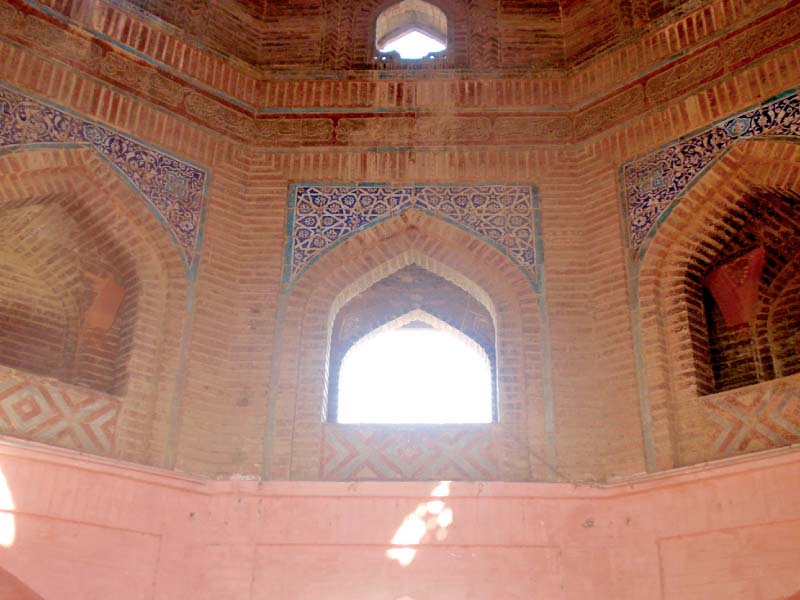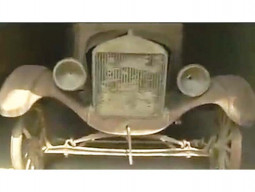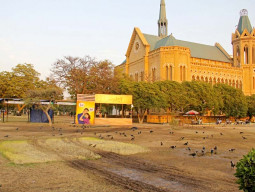
Constructed more than 400-years-ago, the towering heritage site still stands tall, defying the apathetic attitude of the government. What the Sindh Auqaf department is concerned about is its yearly contract, which is awarded to a contractor for Rs469,000 plus 10% tax. However, no repair or renovation of the historic structure has been carried out during the last 20 years, leaving it at the mercy of mother nature.
Uch Sharif: where the shrine culture began
The minaret was constructed by Syed Nizamuddin Shah, also known as Mir Masoom Shah Masoomi, who was the governor of Sindh during the era of Mughal emperor Akbar. Besides being a renowned diplomat, Shah was also a poet and writer. In 1582, he constructed a baradari, which is a 50-feet high domed sanctuary with 12 doorways, to get away from the hubbub of Old Sukkur.
After the completion of the baradari, Shah began constructing the minaret, which took 23 years to complete. Shah personally supervised its construction for 16 years and then, after his death in 1598, his son Syed Abu Mohammad Shah continued the work until its completion in 1605. The tower was then inaugurated by Emperor Akbar. At first the minaret served as a watch tower and was later opened for the general public.
According to the history of the construction of the minaret, bricks made of special stone from Jaipur were used for its construction. It is said that the stone was crushed into powder form and then moulded into bricks, which were later boiled in oil. Those bricks were plastered together with a strange mixture that includes lentils, crushed bones of goats, cows and other animals, sand and water. A unique feature of the minaret is that it is 84 feet high, the circumference at its base is 84 feet and the number of its stairs is also 84. The Mir Masoom Shah Minaret is slightly tilted towards the baradari, which, according to historians, might be a flaw in the construction or the aftereffects of the earthquake which jolted Sindh in 1828.
Shabir Ahmed Brohi, the manager of the Auqaf department, Sukkur, told The Express Tribune that as far he remembers the major repair and maintenance of the baradari, minaret's stairs and re-plastering of its upper portion was carried out in 1986 by the archeology department. Repairs and renovation was also done back between 1997 and 1998 but since then nothing has been done except for fixing tiles at the platform of the minaret, he lamented. "The chief administrator of the Auqaf department awards a yearly contract of the minaret to a contractor and the current contract was awarded for Rs469,000 plus 10% tax," he said.
Conservation of Buddhist, Mughal era historical sites in Punjab on the cards
The contractor has deployed an employee at the minaret, who charges Rs15 and Rs10 from the visiting adults and minors respectively. An official of the Auqaf department requesting anonymity said that in 2010 Rs25 million was allocated by the federal government for the repair and renovation of the minaret and baradari but nothing was done. "Due to criminal neglect the stairs of the minaret have become slippery and people have to be very careful while going up," he added. The chief administrator of the Auqaf department, Mushtaq Ahmed Soomro, was not available for comments.
Till the 1980s and early 1990s there were no high-rise buildings in the city therefore the minaret was visible from everywhere. The mushrooming high-rise buildings in the city now overshadow the towering structure and it has now been lost in the jungle of cement and concrete. Besides this, the minaret has two more towers, Ghanta Ghar and Pir Illahi Bux Tower, and all of them seem to be receiving step-motherly treatment by the Sindh government.
Published in The Express Tribune, February 7th, 2017.




































COMMENTS (1)
Comments are moderated and generally will be posted if they are on-topic and not abusive.
For more information, please see our Comments FAQ